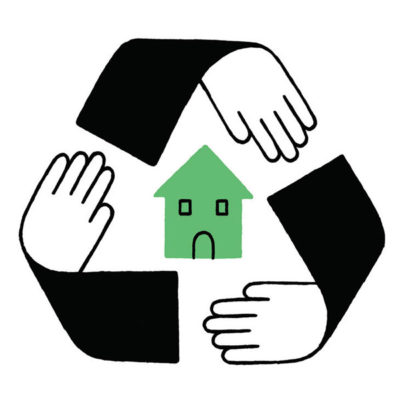The four students scoured the suburban house like Ghostbusters. But instead of proton packs, they wielded infrared cameras and a gigantic fan. And rather than searching for paranormal activity, they sought cracks, leaks, and other places where heat might escape.

Illustration: Miguel Porlan
The hands-on exercise was part of a class called “Introduction to Sustainability,” offered jointly by Babson, Olin, and Wellesley colleges. Students from all three institutions can earn a certificate in sustainability; students may opt to emphasize different aspects of sustainability, depending on their interests, but the co-taught course, part of the Babson-Olin-Wellesley (BOW) Collaboration and helmed by one instructor from each school, is one of the shared requirements.
The course is intended to provide a philosophical, social, and practical framework for the study of sustainability, but its centerpiece is the energy audit. Working in groups, students spent several hours at local houses whose owners, members of the colleges’ communities, volunteer for the task.
As the students roamed the house, aiming their infrared camera at corners and windows, Olin instructor Tess Edmonds talked them through the tasks. When the camera’s display showed areas of blue, students recognized heat-loss trouble spots. “It’s so blue in there,” Edmonds said of a drafty, disused bedroom. “There’s probably some conductive energy loss through the seam in this corner.”
Later, the group wrestled into place a blower door, essentially a large fan used to change air pressure in a building and measure its airtightness. They surveyed the owners about their energy usage and took one last set of measurements before departing. About two months later, they gave the homeowner a detailed report about their findings and recommendations for improving the house’s efficiency, from unplugging unused appliances to installing a solar hot-water heater.
Why such a deep dive into the nuts and bolts of a home-energy audit? The idea, say the instructors, is to take students from the big picture to specifics, as well as to provide a microcosm of certain sustainable practices that can have a broad impact when enacted on a larger scale. “We always try to make the point that this is a very complex problem, sustainability. There are no easy solutions,” says Dave Chakraborty, the instructor from Wellesley. “But we also have to be optimistic and take concrete steps, however small, to change the system, and the home energy audit is just that.”
Jacob Allread ’20 hadn’t thought much about sustainability before coming to Babson. But a course on nature and the environment—chosen, he says, “at random”—piqued his interest. He enrolled in the intro course and now plans to earn the sustainability certificate. This class, he says, has been eye-opening: “It’s not just about the environment. Society also needs to be sustainable; the economy needs to be sustainable.” Much of the study of sustainability, he says, is abstract. But “being able to see and almost touch what was going on in the house during the audit was incredibly valuable.” He also appreciated being part of a BOW class. “Olin and Wellesley students bring a whole different dynamic to the table, which I love.”
Course instructor Michelle Graham, a lecturer in Babson’s Arts and Humanities Division, speaks of a “paradigm shift” in the approach to sustainability—one that will require new ways of doing business across the board. Of her students, she says, “Their generation grew up watching the Arctic ice melt. They see the evidence before their eyes. It’s not just academic; this is their future.”
Adds Olin’s Edmonds, “If this class creates more curiosity about different ways of looking at these really complex issues—for me, that’s success.”—Jane Dornbusch
